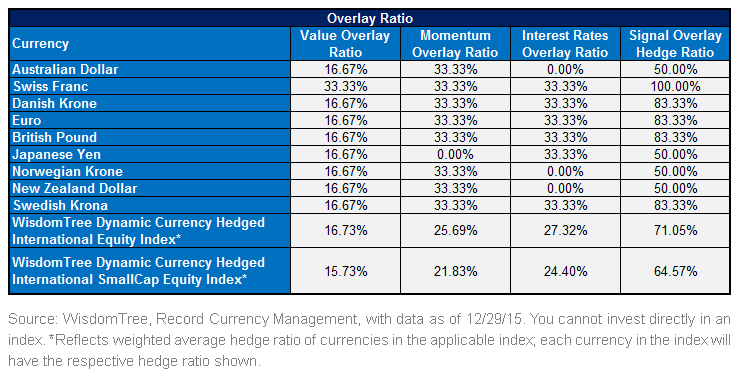How Much Should You Hedge Currencies Today?


 For definitions of terms in the chart, visit our glossary.
The currency-hedge signals are determined on an individual currency basis, but in aggregate, for the developed world currency exposures in the WisdomTree Dynamic Currency Hedged International Equity Index, the models suggest hedging 71.05%, and for the WisdomTree Dynamic Currency Hedged International SmallCap Equity Index, they suggest hedging 64.57%.
These models are by nature dynamic, and when it is more/less favorable to hedge, some of these hedge ratios will come up/down.
While many investors think they missed the opportunity to switch to currency-hedged strategies, we reiterate that we believe the most important drivers of long-term currency movements suggest hedging a majority of your currency exposures today.
1Source: Morningstar Direct. Europe refers to the universe of U.S.- listed mutual funds and ETFs within the Europe Stock peer group. Japan refers to the universe of U.S.- listed mutual funds and ETFs within the Japan Stock peer group. Broad international refers to the universe of U.S.- listed mutual funds and ETFs within the Foreign Large Value, Foreign Large Blend and Foreign Large Growth peer groups. Data is as of 11/30/2015.
2Source: Morningstar Direct. Same universes and as of date as the prior footnote.
3Source: Bloomberg, with data as of 12/31/15.
4Developed world currency exposures refer to those defined by the MSCI EAFE Index universe from 12/31/1988 to 9/30/2015.
5Source for paragraph: Record Currency Management, with data from 12/31/1988 to 9/30/2015.
6No WisdomTree Fund is sponsored, endorsed, sold or promoted by Record Currency Management (“Record”). Record has licensed certain rights to WisdomTree Investments, Inc., as the index provider to the applicable WisdomTree Funds, and Record is providing no investment advice to any WisdomTree Fund or its advisors. Record makes no representation or warranty, expressed or implied, to the owners of any WisdomTree Fund regarding any associated risks or the advisability of investing in any WisdomTree Fund.
For definitions of terms in the chart, visit our glossary.
The currency-hedge signals are determined on an individual currency basis, but in aggregate, for the developed world currency exposures in the WisdomTree Dynamic Currency Hedged International Equity Index, the models suggest hedging 71.05%, and for the WisdomTree Dynamic Currency Hedged International SmallCap Equity Index, they suggest hedging 64.57%.
These models are by nature dynamic, and when it is more/less favorable to hedge, some of these hedge ratios will come up/down.
While many investors think they missed the opportunity to switch to currency-hedged strategies, we reiterate that we believe the most important drivers of long-term currency movements suggest hedging a majority of your currency exposures today.
1Source: Morningstar Direct. Europe refers to the universe of U.S.- listed mutual funds and ETFs within the Europe Stock peer group. Japan refers to the universe of U.S.- listed mutual funds and ETFs within the Japan Stock peer group. Broad international refers to the universe of U.S.- listed mutual funds and ETFs within the Foreign Large Value, Foreign Large Blend and Foreign Large Growth peer groups. Data is as of 11/30/2015.
2Source: Morningstar Direct. Same universes and as of date as the prior footnote.
3Source: Bloomberg, with data as of 12/31/15.
4Developed world currency exposures refer to those defined by the MSCI EAFE Index universe from 12/31/1988 to 9/30/2015.
5Source for paragraph: Record Currency Management, with data from 12/31/1988 to 9/30/2015.
6No WisdomTree Fund is sponsored, endorsed, sold or promoted by Record Currency Management (“Record”). Record has licensed certain rights to WisdomTree Investments, Inc., as the index provider to the applicable WisdomTree Funds, and Record is providing no investment advice to any WisdomTree Fund or its advisors. Record makes no representation or warranty, expressed or implied, to the owners of any WisdomTree Fund regarding any associated risks or the advisability of investing in any WisdomTree Fund.
Important Risks Related to this Article
Hedging can help returns when a foreign currency depreciates against the U.S. dollar, but it can hurt when the foreign currency appreciates against the U.S. dollar.
Investments focused in Japan or Europe increase the impact of events and developments associated with the regions, which can adversely affect performance.

Jeremy Schwartz has served as our Global Chief Investment Officer since November 2021 and leads WisdomTree’s investment strategy team in the construction of WisdomTree’s equity Indexes, quantitative active strategies and multi-asset Model Portfolios. Jeremy joined WisdomTree in May 2005 as a Senior Analyst, adding Deputy Director of Research to his responsibilities in February 2007. He served as Director of Research from October 2008 to October 2018 and as Global Head of Research from November 2018 to November 2021. Before joining WisdomTree, he was a head research assistant for Professor Jeremy Siegel and, in 2022, became his co-author on the sixth edition of the book Stocks for the Long Run. Jeremy is also co-author of the Financial Analysts Journal paper “What Happened to the Original Stocks in the S&P 500?” He received his B.S. in economics from The Wharton School of the University of Pennsylvania and hosts the Wharton Business Radio program Behind the Markets on SiriusXM 132. Jeremy is a member of the CFA Society of Philadelphia.

